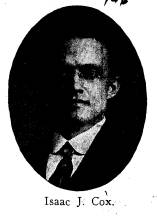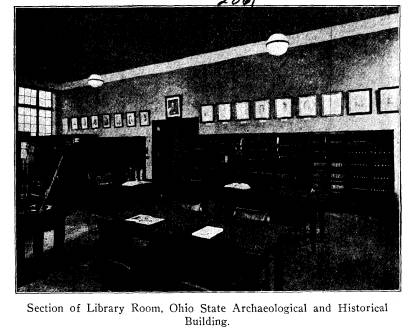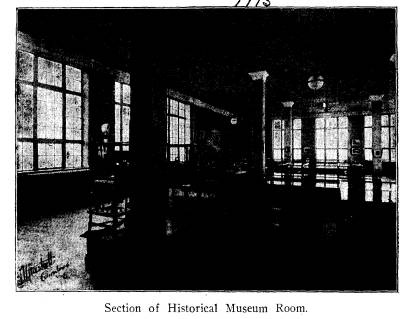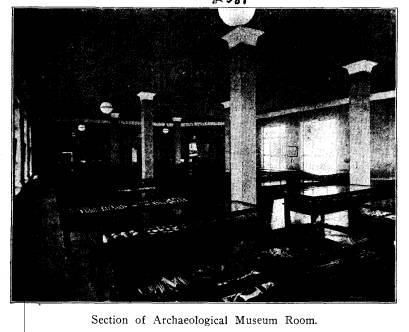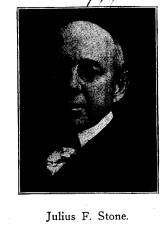Ohio History Journal
- 1
- 2
- 3
- 4
- 5
- 6
- 7
- 8
- 9
- 10
- 11
- 12
- 13
|
362 Ohio Arch. and Hist. Society Publications.
ADDRESS OF ISAAC J. COX. [The subject of Prof. Cox's address was "Ohio and Western Sectionalism." Prof. Cox is professor of American History in the University of Cincinnati. He is president of the Mississippi Valley Historical Society and was formerly president of the Ohio Valley Historical Society.] It is a truism to state that natural forces determine the es- sential facts of history, but at the same time, we may assert that men of vision show the way in which these forces are to ex- press themselves. In this brief attempt, therefore, to give a per- |
|
|
|
the commercial routes of a later day. Even before the aborigines, the buffalo, and before him prehistoric animals that have long since disappeared, suggested lines of travel and congregation that are familiar to us. The chief physiographic features of a pre- historic age and of our own day are based on the fact that to the eastward of this region rose the mountain barrier of the Alle- ghanies; that past its western borders flowed the mighty torrent of the Mississippi; to the north lay the largest group of fresh water lakes on the surface of the globe; while its southern shores were washed by the waters of the Mexican Gulf. Through its interior, dividing it into two equal sections, wound the beautiful Ohio, the destined course of western empire. These were the es- |
|
Dedicatory Exercises May 30, 1914. 363
sential factors that determined the ultimate development of a western sectionalism which would either weld distant areas into a more perfect Union; or, if perverted, cause them to separate into warring fragments. Whether in the Union or out of it, the trans- Alleghany section must exert an influence second to no other. That this section has been ultimately devoted to nationalism, was largely determined by the position of the Ohio Valley and the fact |
|
|
|
that its northern portion was the first important offspring of the American Union. Passing over those influences contributed by the beasts of the wilderness and by primeval man-influences which in themselves are of singular importance and well worth the study of this and similar organizations, we come to the advent of civilization and propose to show how the men of the western waters first de- veloped a stalwart sectionalism, which in turn became an im- portant element in our national existence. We may term this |
364 Ohio Arch. and Hist. Society Publications.
the period of approach, and it is
fittingly ushered in by the ro-
mantic figure of the French explorer,
Robert Cavalier de La-
Salle. The incidents of his presence in
the upper portion of the
Ohio Valley and within the present
limits of our state, are not
sufficiently well known to require more
than the most brief gen-
eralization, but taken in connection
with his whole career, we
may suggest that to the pioneer
Frenchman there appeared in
this trans-Alleghany region, a triple
vision that the succeeding
centuries have abundantly confirmed. In
the first place, LaSalle
had a vision of the commercial
possibilities of this section. The
fur trade that led so many pioneer
Frenchmen into the wilds of
the vast interior or to the frozen
regions of the North, pre-
sented its attraction to this intrepid
Frenchman. He relied upon
this single form of natural wealth to
achieve his far-reaching
plans of national aggrandizement. It
proved inadequate as an
expression of the boundless resources of
this region, yet the fur
trade that he and his contemporaries
initiated served to support
a pioneer existence in which Frenchman,
Briton and American
played their parts, and developed lines
of expansion that ter-
minated only with the frozen Arctic and
the far Pacific. Now
teeming multitudes, alien to the great
explorer, gain from our
natural wealth a richness of life of
which he was only dimly
aware.
A second vision that was granted to
LaSalle was that through
this system of interior waterways, he
might open up a way of
approach to Mexico. It was this prospect
that led the Grand
Monarque to give him permission to penetrate the vast interior
of
North America. It is true that in his
later efforts, LaSalle em-
phasized the routes through Illinois
rather than those to the
Eastward, but his brief tarrying on the
upper courses of the
Ohio, while contemplating a chance of
approach to the Spanish
dominions, for all time to come linked
this immediate region with
the lure of the far Southwest. Following
him as the pioneer
adventurer, came a host of others whose
later visions were tan-
talized by the inexhaustible wealth of
the Mexican mines. More
than a century later the western boatmen
of this section formed
recruiting force for the filibustering
expeditions with which Burr
and his contemporaries vainly attempted
to reach the same goal
Dedicatory Exercises May 30, 1914. 365
that beckoned the indomitable Frenchman.
Incidentally we may
say it was no policy of watchful waiting
or benevolent assimila-
tion that attracted these worthies.
A third vision that stirred the ambitious Frenchman was the
hope that the river along which he was
passing, leading into still
other and mightier streams, in
due time might find its way into
the distant Vermilion Sea. Thus it
appeared to him that he
was on a commercial highway to the
Pacific and to the far East,
a possible route that had attracted
explorers since the days of
Columbus. Again LaSalle was a prophet
far in advance of his
time, for it is only in our own day,
with means and with measures
that he could not have dreamed of, that
we are about to open
this highway between the cloven
continents. Through a system of
improvements that give us access to the
Gulf and the Caribbean;
through this wonderful channel that
actually bridges a continent,
we now behold a chain of communication
from the foothills of
the Alleghanies to the uttermost parts
of the former Spanish
Main and to the distant Indies
themselves. Yet in the proud
day of achievement, let us not forget
that upon some portion of
this very soil, LaSalle first conceived
this wonderful triple vis-
ion which has materialized into the
political unity of the inte-
rior of the American continent, the
commercial unity of both
Americas and the essential solidarity of
all nations bordering on
the Pacific.
With the vision of marvelous growth came
the portent of
mighty conflict. English explorers were
approaching this western
region even in the time of LaSalle, but
some forty years passed
ere their early representatives began to
affect their governmental
policy. The figure that can best be
compared with LaSalle is the
Virginia executive, Alexander
Spottswood. With his interest
early aroused in this western country he
was led to predict that
it would become the scene of conflict
between the French and
English of North America, a full half
century before this ac-
tually broke out. He led in a notable
attempt to explore this
western country, and although he reached
only the crest of the
Blue Ridge, he imagined that through the
haze of that summer
day in 1716, he beheld the distant
waters of Lake Erie. While his
exaggerated report represents a vision
of faith rather than of
366 Ohio Arch.
and Hist. Society Publications.
reality, we may well believe that had he
been given an insight
into the future comparable to the
reality of his supposed vision,
he would have been doubly insistent on
securing this mighty em-
pire that had beckoned him westward. As
a result of his sur-
vey, we know that he emphasized the
importance of aggressive
action in seizing this territory ere the
enemies of England should
occupy it and roll the tide of war
through the mountain passes
and over the colonies to the Eastward.
He would divide French
settlements to the North and to the
South by a series of pro-
jected English posts leading to the
waters of Lake Erie and even
into the wilds beyond. But like the
great LaSalle, his prophecy
and his importunity alike remained
unheeded until threatening
peril a half century later aroused the
English to a sense if immi-
nent danger.
The prospect of international conflict
grew with each decade
of the eighteenth century. Gradually the
French approached the
upper portion of the Ohio Valley. As a
sort of final effort in
their insidious advance, occurred the
expedition of Celeron de
Bienville, who in 1748 attempted to mark
Bourbon dominion in
this region by placing leaden plates at
the mouths of certain
rivers. This inconclusive method of
planting lead promised to
be succeeded by other chances when, two
years later, Christopher
Gist crossed the Alleghanies,
prospecting for that "good level
land" that has tempted the
English-speaking people to the utter-
most parts of the earth. The work of
Gist and of Boone, fit
representatives of a long line of
hunters, surveyors, prospectors
and settlers, promised a conflict not
merely with the French
but also with the Indians, who claimed
this western territory by
immemorial right. The details of this
long-drawn out and ever-
doubtful struggle, form a page without
rival in the history of
human expansion. Here Gaul and Briton
contended for over-
lapping claims. Here civilization and
savagery carried on their
never-ending conflict that leads to only
one result. And in the
midst of this warfare of primeval and
international forces a new
nation likewise came into being to
receive its baptism on Ohio
soil in the following imperishable
words: "Love of liberty and
attachment to the real interests and
just rights of America out-
weigh every other consideration, we
resolve that we will exert
|
Dedicatory Exercises May 30, 1914. 367
every power that is within us for the defense of American liberty and for the support of her just rights and privileges; not in any precipitate, riotous, or tumultuous manner but when regularly called for by the unanimous voice of our countrymen." In this prophetic manner was national liberty and union prefigured on the soil of our state November 5, 1774, by western pioneers, called out by a British governor in pursuit of the savage. From the midst of this frontier conflict there emerged the hope of na- |
|
|
|
tionality; in the later expression of a multitude of such resolu- tions, nationality itself. Of the great figures who played their titanic parts in this double contest with natives and with national rivals, we can only make the barest mention, but in passing we must briefly note one who occupies an unapproachable position in our national his- tory, but who incidentally drew from this western country many of the qualities that rendered him first in the hearts of his coun- trymen and foremost among the men of modern times. George |
368 Ohio Arch. and Hist. Society Publications.
Washington, the young surveyor, was an
early western prospec-
tor, a diplomatic messenger between the
contending factions of
England and of France, a frontier
commander in the most cruel
days of the struggle for the upper Ohio
Valley, and a shrewd
speculator in western lands both before
and after the contest with
the mother country. A man of vision, who
saw in this western
country one of the strongest ties to
bind together the original
states that formed the American Union,
he felt that the essential
problem of the West was one of
communication. Once this were
solved, the central government need fear
neither the natural dis-
ruptive spirit of the pioneer nor the
temptations of British or
Spanish hirelings. In his closing days
he exerted the power re-
posed in him by the new nation to defend
the outlying com-
munities that it had created. Thus in
his public career of nearly
half a century, he contributed to every
significant movement
that affected this western land and in
the end saw its destiny
safely united to the nation which was at
once its creator and its
beneficiary.
It was not to be expected that the idea
of separation cher-
ished by the physical features of the
country, the pioneer spirit
of its earlier inhabitants, and the
vicious intrigues of British and
Spanish agents, would easily disappear.
When LaSalle and
Spottswood marked this region as the
scene of conflict for su-
premacy between their respective
nations, they stirred up forces
that would long survive them. Even when
the population of the
Ohio valley was politically united with
that of the states of the
eastward, with many ties of kindred
origin to make this union
permanent, these personal and physical
forces still tended to
sectionalism and even to a movement for
independence. The
worst of these forces center around the
career of General James
Wilkinson. Willing to employ the
commercial opportunities of
the region to his advantage, he turned
the commendable demand
of the western people for an outlet to
the Gulf into a means for
commercial bargaining with the Spaniard.
His visit to New
Orleans in 1787 ushers in the most
corrupt intrigue in our po-
litical annals. Fortunately in that same
year there was inaugu-
rated a national movement that was
destined not only to coun-
teract his intrigues but to prevent
their more far-reaching effects.
Dedicatory Exercises May 30,
1914. 369
The Congress under the Confederation-the
same body that had
proposed to limit the sale of western
lands and close the Mis-
sissippi for a period of years-more than
atoned for its remis-
ness in these respects by the famous
Ordinance creating the
territory northwest of the Ohio. This
wise measure of state
policy has proved to be the best gift
which the East ever be-
stowed on the West, and our own state of
Ohio, the first fruit of
this policy, has been the one to profit
most by it. Through its
provisions the new territory was to
secure freedom in religion,
freedom and encouragement in education,
freedom in the dis-
tribution of property, and last and by
no means the least, freedom
from the worst effects of the
institution of slavery.
The best results of this policy were not
immediately ap-
parent. Under national auspices new
western communities were
founded, whose outlying settlements must
be protected from the
murderous savage. After mortifying
failures, Washington, the
firm and far-sighted friend of the West,
selected his former sub-
ordinate Wayne to accomplish this
necessary task. It is inter-
esting to note that in the campaign of
1793-94, the campaign
which redeemed the greater part of Ohio
from the Indian peril,
Wayne, the representative of stalwart
nationalism, and Wilkin-
son, the agent of perfidious intrigue,
were closely but not in-
timately associated. Wilkinson hampered
Wayne in his funda-
mental purpose, and by so doing, misled
rather than represented
the Kentucky contingent. Fortunately he
was unable to over-
throw the other's plans and ultimately
the victory at Fallen
Timbers gave a new impulse to
nationalism in the West, and
partially broke the Spanish spell over
the wavering Wilkinson.
When another phase of sectionalism
showed itself in the
famous Kentucky resolution of 1798-99,
it awoke an answering
response north of the Ohio River. Here
the forces of Federal-
ism and those of particularism were
engaged in a contest over
the division of the territory and the
admission of a portion into
the Union as a state. Fortunately this
new sectional develop-
ment was merged into a national movement
by the election of
Jefferson in 1800. This peaceful
democratic revolution was
shortly followed by the admission of
Ohio as the seventeenth state
Vol. XXIII- 24.
370 Ohio Arch. and Hist.
Society Publications.
of the American Union. Thus, in the
course of two decades, the
national movement which was ushered in
by the cession of
western territory to the general
government, developed to full
fruition in the admission of the first
of the states from the
ceded territory. Ohio, as the child of
the national government,
never forgot its filial devotion to its
creator.
It was hardly likely that the states of
this western region,
though adopted or created by the
national government, should
immediately abandon all strictly
sectional feeling. Their leaders
emphasized this when they forced the War
of 1812 upon the hes-
itant Madison. Ohio, like its sister
state of Kentucky, opposed
the national policy represented by the
Second United States bank,
and quoted from the Kentucky and other
similar resolutions to
justify its attitude. Our state likewise
asserted a particularistic
policy to justify its claims to the
Toledo district, even though
this policy brought into question the
Ordinance of 1788, under
which it was created. But at length
those measures for which
it had most strenuously fought, either
alone or in company with
its sister states, became cardinal
principles of national policy.
On the other side of the picture it is
comforting to note that
Ohio and her sister states of the
Northwest played a conspicuous
part in combatting some of the
expressions of western section-
alism during the early 19th century. It
assisted to arouse public
opinion and force the problem of the
open Mississippi upon Jef-
ferson's administration. This led to the
acquisition of ouisiana,
the most significant national event
after the Declaration of In-
dependence and the adoption of the
Constitution. In company
with Kentucky, but even more
instrumental than that state, Ohio
gave the deathblow to the Burr
conspiracy, whatever that move-
ment represented. Burr himself is
reported to have said that he
felt confident of all the western people
except those of Ohio.
He told Tupper, of Marietta, "You
should make yourself of con-
sequence." Her sons abundantly
followed this injunction. Side
by side Kentusky and Ohio fought the
British in the War of
1812, with Perry's victory and the
Thames river to mark their
final success in expelling the invader,
if not in pushing their
conquests into Canada. In this same
struggle the last significant
Indian confederacy under Tecumseh was
dissolved and the Indian
peril removed from the Northwest. In
these events Kentucky
|
Dedicatory Exercises May 30, 1914. 371
played the part of elder sister, for which it was to receive its reward a half-century later. During this warfare, two conspicuous figures received the stamp of Ohio. William Henry Harrison, a representative of Virginia, who settled between the Miamis, did yeoman service against the savages that threatened Indiana and Illinois, while Lewis Cass took up the task of the nerveless Hull and was the |
|
|
|
most tireless opponent of British intrigue in the Northwest. It was fitting that these two men should later play a conspicuous national part, the one as a brief occupant of the presidential chair and the other as a prominent candidate for the same po- sition. Through the irony of fate, the Virginian, Harrison, rep- resented the nationalistic tendencies of a later generation while the New Englander, Cass, was an active supporter of the latter particularistic doctrine of popular sovereignty. Thus far we have considered the part played by Ohio in |
372 Ohio Arch. and Hist. Society Publications.
early western sectionalism. Time fails,
although the day and
occasion demand some attention to that
bitter discussion which
emphasized a later sectional movement in
our country. In the
beginning the line of sectionalism
followed the course of the
Alleghany mountains, and a possible
cleavage threatened to divide
the country into an East and a West.
This was suggested by La-
Salle and repeated by a later Frenchman,
Laussat, on the eve
of the Louisiana transfer. Many
intervening measures of popular
policy emphasized this tendency, but all
real danger of such a
sectionalism disappeared with the
overthrow of Burr's abortive
attempt. The more threatening slavery
discussion produced a
sectionalism, from which emerged a North
and South. Many of
the events in Ohio's history suggest a
wavering upon this ques-
tion. During the critical days of the
Nullification Controversy,
William Henry Harrison, Junior, voiced
the Union sentiment
which the older generation of his
section cherished as well as his
own, in these stirring phrases:
"Born and raised a freeman,
and my ancestors having contributed
freely, and risked much to
gain, maintain, and support our happy
government, I feel an
indignation I cannot express against
those who are for raising the
standard of Nullification, which
I consider a decent term for re-
bellion and treason." Then in
characteristic Ohio fashion he
commends himself to the President as
commander of a regiment
of volunteers, and promises within a
month after marching to
"ride through the streets of
Charleston."
Less than a decade later Ohio is
interested in the projected
construction of railroads to the
seaboard. One of the favorite
proposals was to connect Cincinnati with
Charleston. Robert
Y. Hayne was the president of the
company that urged the proj-
ect and one wonders how history might
have been changed had
it been realized at that time rather
than in our own day. In-
fluences were then at work to break this
desired connection with
the Southeast. The names of Levi Coffin,
Harriet Beecher
Stowe, Thomas Morris, Joshua Giddings
and Salmon P. Chase,
to mention no others, indicate a
personal influence that in time
turned Ohio into an anti-slavery state.
When as a result of their
efforts the slavery question became a
national issue, and when in
eleven of the commonwealths the die was
cast in favor of seces-
Dedicatory Exercises May 30,
1914. 373
sion, it was the positive attitude of
Ohio that largely restrained
western Virginia and Kentucky from
taking the same step. In
this way did our state repay the debt
incurred by her during the
long period of struggle against the
Indians and British.
In this mournful sectional conflict we
must pass over the
long list of names that constitute
Ohio's honorable muster-roll.
Suffice it to indicate in the career of
two of the names of this
period and the contrasting influences
that affected her people.
At the outbreak of this struggle,
William Tecumseh Sherman was
the popular president of the institution
which has since become
the University of Louisiana. Pressed to
espouse the side of
secession, he refused to lift his hand
against the Union. Later
uttering his opinion that 200,000 men were
necessary to hold the
Mississippi Valley, he was regarded as a
fit subject for a mad-
house. But Ohio herself furnished more
than half as many
again before the men of the western
waters accomplished the
task of reopening the Mississippi and of
sweeping around the
Alleghanies, through Georgia, to the
seaboard.
Contrast with his position this
expression from a speech
of Clement L. Vallandigham: "The
war of the Union is in your
hands, a most bloody and costly
failure." It was indeed most
bloody, for it was sanctified with the
best blood of the nation,
North and South. It was most costly;
after a lapse of a half
century we are still paying for it. But
was it a failure? Let
Santiago and Vera Cruz, distant Manila
and Pekin reassure the
halting few that survive the mighty
test. Ohio thus nobly re-
fused to put its stamp of approval on
Vallandigham's dictum.
In this hurried sketch of an earlier
sectional movement that
influenced the later life of our State,
one may discern the mighty
impulses that have quickened the life of
commonwealth, section,
and nation. The interplay of these
forces afford the most sig-
nificant problems of our national
government. To ascertain how
they act and with what ultimate result,
is a task that engages
the best efforts of historical training.
That these efforts may be
aided and rendered effective, is the aim
of The Ohio Archaeo-
logical and Historical Society, and of
every similar organization
of our land. In its museums, its
libraries, its manuscript col-
lections are to be found materials for
exploiting the workings
|
374 Ohio Arch. and Hist. Society Publications.
of these forces. The efforts of those in charge are directed to the best utilization of this material and they should be sustained and supported in their endeavors to make it still more useful. With this in mind, may we not anticipate a development in which this Society as a parent organization shall create others, repre- senting each county of our State, all engaged in collecting the vast resources of historical scholarship and in rendering them available to specialists? These in turn must by their labors show the general public the importance of our local and sectional his- tory, and the necessity for preserving its data. In this way we may render still further honor to those who have made the his- tory of our state famous and incite others to make its present and future development equally significant and equally valuable in the life of our common country. * * * * * Following the address of Prof. Cox, addresses of greeting and congratulation to the Society were made by Mrs. Ella May Smith, of Columbus, representing the New England Historic Genealogical Society, located at Boston, Mass; Mr. Charles F. Brush, of Cleveland, Ohio, representing the American Philo- sophical Society, of Philadelphia, Pa. |
|
|
|
building might be erected. Indeed, they had accorded it the choicest site upon the entire campus, and in this policy they had |
|
362 Ohio Arch. and Hist. Society Publications.
ADDRESS OF ISAAC J. COX. [The subject of Prof. Cox's address was "Ohio and Western Sectionalism." Prof. Cox is professor of American History in the University of Cincinnati. He is president of the Mississippi Valley Historical Society and was formerly president of the Ohio Valley Historical Society.] It is a truism to state that natural forces determine the es- sential facts of history, but at the same time, we may assert that men of vision show the way in which these forces are to ex- press themselves. In this brief attempt, therefore, to give a per- |
|
|
|
the commercial routes of a later day. Even before the aborigines, the buffalo, and before him prehistoric animals that have long since disappeared, suggested lines of travel and congregation that are familiar to us. The chief physiographic features of a pre- historic age and of our own day are based on the fact that to the eastward of this region rose the mountain barrier of the Alle- ghanies; that past its western borders flowed the mighty torrent of the Mississippi; to the north lay the largest group of fresh water lakes on the surface of the globe; while its southern shores were washed by the waters of the Mexican Gulf. Through its interior, dividing it into two equal sections, wound the beautiful Ohio, the destined course of western empire. These were the es- |
(614) 297-2300
